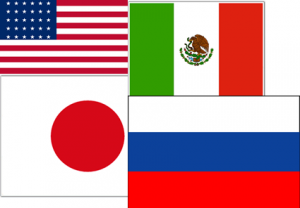Which Countries Are Doing the Best in the World of Boxing, and Why?
In a short amount of time, the boxing landscape has changed dramatically. Shifting economic and social climates around the world have finally taken hold, leading to a new look for the sport.
In order to achieve a statistical comparison, I took two sets of Ring ratings—the most recent issue and one from 1998. The reason for picking Ring was that they normally have very sound rankings with a history that allows one to reference rankings from deep in the past. I’m only going back a dozen years. It’s not a lot of time, but so much has changed.
With the top 10 fighters in each class represented, that’s 170 + fighters whom are ranked across 17 divisions, including champions. There are certainly other ways to measure this, but this chart indicates how many top-ten fighters each country had in 1998, compared with today.
1998……… 2010
United States 59 25
Mexico 23 21
Russia (+ fmr. republics) 4 19
United Kingdom 8 11
Japan 3 15
Thailand 11 4
South Africa 5 9
Rest of Africa 4 4
Philippines 4 7
Argentina 4 5
Germany 4 4
Puerto Rico 2 6
Venezuela 4 3
Colombia 4 2
France 5 1
Poland 1 4
Canada 1 3
South Korea 3 0
Italy 2 1
Panama 0 3
Nicaragua 1 2
Indonesia 0 2
Romania 0 2
Cuba 1 1
Dominican Republic 0 2
Iraq 0 1
Spain 0 1
Denmark 0 1
Slovenia 0 1
Jamaica 0 1
Haiti 0 1
Hungary 0 1
Yugoslavia 0 1
What do We Make of These Statistics?
The Fall of Communism = The Fall of the USA
 The first thing that jumps out from this chart is the drop in U.S. fighters and the rise of fighters from Russia, the former Soviet republics and Eastern-bloc countries. The heavyweight division is a microcosm of what has taken place. In 1998, 8 of the top-10 heavies were American and now 8 of the top-10 are Eastern Europeans.
The first thing that jumps out from this chart is the drop in U.S. fighters and the rise of fighters from Russia, the former Soviet republics and Eastern-bloc countries. The heavyweight division is a microcosm of what has taken place. In 1998, 8 of the top-10 heavies were American and now 8 of the top-10 are Eastern Europeans.
It’s not a stretch to say that the rise in Eastern European fighters has come largely at the expense of the United States. The fighters from these countries that only recently even permitted pro boxing are bigger men, usually middleweights and above. That used to be an area dominated by American fighters, but not anymore.
This should have been more predictable. After all, former communist countries have always had eager men willing to fight simply for national pride. With financial freedom and international fame now at stake, it figured that they would make their presence felt at some point.
These things don’t happen overnight. While the fall of communism in Europe was complete by the early-90’s, it took some time to register. The first wave of Russian fighters in the 90’s didn’t fare so well, but as more fighters took to the pro ranks, they began to adapt better. Looking at the Ring ratings now, there are at least 28 fighters who are from countries where pro boxing is a new phenomenon. There was a time not very long ago when these 28 fighters wouldn’t have even been allowed to fight professionally.
But the fall of top-10 U.S. fighters from 59 to 25 in a mere dozen years is not simply due to the rise of Europe. The sport has lost some of its popularity in the states. In addition, the groups we drew most American stars from have risen up the socio-economic ladder. The least-privileged groups usually box the most. As African-Americans and Hispanics in the U.S. continue to improve their standing, boxing becomes less of a practical alternative.
Boxing in general is just so much of a less attractive option to American athletes. Parents, having seen every other American boxing star end up broke or brain-damaged, are pushing their kids away from the sport. That’s why the next great American heavyweight is probably playing small forward in the NBA or outside linebacker in the NFL. Now with the rise of MMA, good American athletes who are inclined to fight have other avenues to pursue –not just boxing.
Countries Holding Steady
Give credit to Mexico for keeping the ball rolling. Mexico is a longtime contributor to the top ranks of the sport. Look for them to continue doing well and maybe even better in the future, as more great fighters bring others into the game.
South America continues to produce. Argentina is seeing a small increase, while Colombia and Venezuela continue to produce a handful of excellent fighters.
Other minor contributors like the Dominican Republic, Nicaragua, and Italy have remained more or less the same.
It might seem surprising that Cuba and Germany have the same amount of entrants that they had in 1998. The feeling is that both countries are on the rise, but the numbers do not bear out this feeling. While Germany has the same amount of its citizens on the list, it has become a hub of Eastern European boxing, with many non-native fighters now based in Germany. Cuba, on the other hand, is still a closed society. With the recent surge in defectors, expect Cuba’s number to rise in the ensuing years. If Cuban fighters are ever allowed to freely pursue their pro careers—watch out!
Countries on the Rise
Russia and its former republics are not the only countries to see a spike. The fall of communism has also allowed fighters from Poland, Romania, Yugoslavia, Slovenia, Armenia, and Hungary to make their impact felt in the top ten.
A boxing renaissance seems to be occurring in South Africa, which now has 9 fighters in the top-10—good for 5th among all countries.
Boom times are happening in Japan, which now boasts an amazing 15 fighters in the top ten—all the more incredible when considering they have no entrants over 130 pounds. Only the U.S. and Mexico have more ranked fighters than Japan.
The United Kingdom has always produced a good number of top boxers. They raised their total from 12 years ago and with a lot of good prospects coming up, that number could rise in the future.
Other countries seeing an increase in the past dozen years are longtime contributors Puerto Rico and Panama. Manny Pacquiao’s success has also rubbed off on his homeland, as the Philippines increased its number, as well. Indonesia even has a couple fighters in the rankings.
Canada has seen an increase in the popularity of boxing. Canada now has 3 ranked fighters on the list, in addition to two major non-native draws (Lucian Bute and Jean Pascal) who regularly fill arenas.
Countries on the Slide
With an astounding 34 less fighters in the rankings than 12 years ago, the U.S. has seen the biggest drop of any nation, probably the biggest drop in boxing history over a 12-year period.
Japan’s renaissance period has come at the expense of Thailand and South Korea, as their numbers have dropped precipitously.
France is a country that usually has a handful of fighters in the top-10, but now only has one fighter in the rankings—a 10th-ranked 115-pounder.
What the Future Holds?
Success begets more success. Countries with high-profile boxing action and a slew of successful fighters will encourage others to participate in the sport, thus keeping their international presence strong and growing.
A larger number of different countries are now represented in the upper reaches of the sport. Always an international sport, boxing has become even more worldwide and this phenomenon will continue into the future.
Russia and surrounding areas are threatening to completely take over the sport, especially in the higher weight classes. Perhaps the possibility exists that the newness of pro boxing will wear off and lead to a decline. Then again, the growing success could give way to even more top fighters from these areas.
Boxing is tied to economics. As groups continue to rise in overall status, they will fight less. As a corollary, the number of black fighters in the top ten from 1998 to today has dropped from 58 to 34. Despite the troubling economy in the U.S., most people now have a decent quality of life, at least better than some places. While improving, the economies in places like Poland, Armenia, Romania, and parts of the old Soviet Union are much less stable. People have fewer options. They have less comfort. These things usually give way to more youth willing to try things like boxing to improve their conditions.
So for the near future, one should expect more of the same. Don’t write off the United States, however. They still have more top-10 fighters than any other country. But for the first time in history, that distinction is being threatened.










